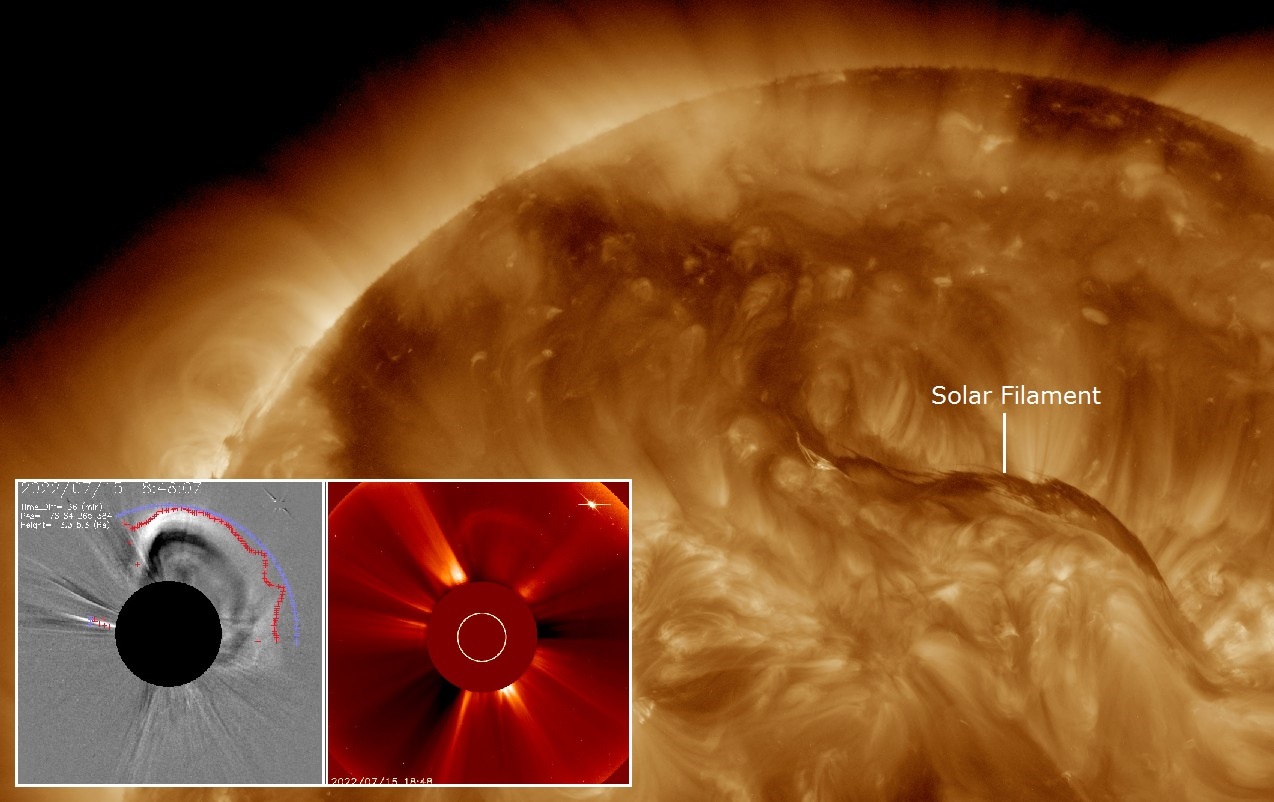‘Fire Canyon’ that opened with filament in the sun releases energy towards Earth that could trigger solar storm | NASA
–
Since yesterday there have been news that a solar storm will hit Earth between today and tomorrow with information that NASA would have issued an alert and that the geomagnetic storm would even have an effect on people’s health, causing, for example, symptoms such as headaches and heart problems. After all, is it true?

in part. A geomagnetic storm can affect planet Earth between today and tomorrow, but there was no special and spectacular warning from the US space agency NASA related to this event. The NASA Sun Twitter account, dedicated especially to the star, has no posts about an impending solar storm. The agency, however, is monitoring the event and its scientists have reported the possibility of a geomagnetic storm.
Formal solar weather warnings are issued by the Space Weather Prediction Center (SWPC), linked to the National Oceanic and Atmospheric Administration (NOAA), the United States government’s weather and climate agency. The SPWC has a warning of minor G1-class geomagnetic storms possible until tomorrow, when a coronal mass ejection is expected to hit planet Earth’s magnetic field. The ejection was launched into space by an unstable filament of magnetism that erupted on July 15.
The solar winds from the breakup of a gigantic filament of “Fire Canyon” on the sun, so they can hit Earth, triggering a weak G1 geomagnetic storm. An event that is not out of the ordinary and has occurred a few times this year without any media attention and without causing major effects.
The long snake-like filament cartwheeled its way off the #Sun in a stunning ballet. The magnetic orientation of this Earth-directed #solarstorm is going to tough to predict. G2-level (possibly G3) conditions may occur if the magnetic field of this storm is oriented southward! pic.twitter.com/SNAZGMmqzi
— Dr. Tamitha Skov (@TamithaSkov) July 16, 2022
Direct Hit! A snake-like filament launched as a big #solarstorm while in the Earth-strike zone. NASA predicts impact early July 19. Strong #aurora shows possible with this one, deep into mid-latitudes. Amateur #radio & #GPS users expect signal disruptions on Earth’s nightside. pic.twitter.com/7FHgS63xiU
— Dr. Tamitha Skov (@TamithaSkov) July 16, 2022
Sun watchers first spotted solar filaments as dark, thread-like lines against the bright background of the sun on July 12. Then, on July 15, a filament snaking through our star’s northern hemisphere erupted, carving a roughly 384,000-kilometer-long, 20,000-kilometer-deep “canyon of fire” on the sun’s surface, spewing solar material directly into the sun. to Earth.

Solar filaments are huge arcs of electrified gas (or plasma) that travel through the sun’s atmosphere at the whims of the star’s powerful magnetic field. These giant magnetic tubes can contain huge masses of plasma above the sun’s surface, but they are also very unstable and once they collapse they can launch explosive jets of solar wind called coronal mass ejections (CMEs) towards Earth.
On planets that have robust magnetic fields, such as Earth, the magnetic field absorbs the flood of solar debris from CMEs, triggering powerful geomagnetic storms. In these storms, the Earth’s magnetic field is slightly compressed by waves of highly energetic particles that run along magnetic field lines near the poles and stir up molecules in the atmosphere, releasing energy in the form of light to create colorful auroras.
3-Day Forecast Issued 2022 Jul 20 1230 UTC:
The greatest expected 3 hr Kp for Jul 20-Jul 22 2022 is 5 (NOAA Scale G1).
S1 or greater: 5%, 5%, 5%. R1-R2: 25%, 25%, 25%.
R3 or greater: 5%, 5%, 5%. https://t.co/gPw8AeBd9u— NOAA Space Weather (@NWSSWPC) July 20, 2022
Classified as a G1 solar storm, the one that could occur in the next few hours has the potential to cause fluctuations in electrical grids and impact some satellite functions, including those for mobile devices and GPS systems, but not drastically. The experts’ projections, therefore, do not indicate greater consequences in space and no risk to the routine of people on Earth, much less health.
More extreme geomagnetic storms can be dangerous and life-altering in society, but according to the SWPC this will not be the case. The eruption of a coronal mass ejection from the sun usually takes about 15 to 18 hours to reach Earth, according to the National Oceanic and Atmospheric Administration’s (NOAA) Space Weather Prediction Center, but it can, as it is now, if move slower and take longer to arrive. This possible storm now occurs as the sun enters its most active phase of its approximately 11-year solar cycle and which is expected to peak between 2024 and 2025, so we will be hearing a lot about solar storms in the coming years.
Astronomers have known since 1775 that solar activity waxes and wanes in cycles, but recently, the sun has been more active than expected, with nearly twice as many sunspot appearances predicted by NOAA. The Sun’s activity is expected to increase steadily over the next few years, reaching an overall maximum in 2025 before decreasing again.
A paper published July 20 in the journal Astronomy and Astrophysics proposed a new model for the sun’s activity by separately counting sunspots in each hemisphere, a method the paper’s researchers argue could be used to make more accurate solar predictions.
Scientists think that the largest solar storm ever witnessed during contemporary history was the Carrington Event of 1859, which released approximately the same energy as 10 billion 1-megaton atomic bombs. After hitting Earth, the powerful stream of solar particles fried telegraph systems around the world and caused auroras brighter than the light of a full moon to appear even in the southern Caribbean.
If a similar event were to happen today, scientists warn, it would cause trillions of dollars in damage and trigger widespread blackouts, far worse than ever before. 1989 solar storm which released a billion-ton cloud of gas and caused a blackout across the Canadian province of Quebec.
–


